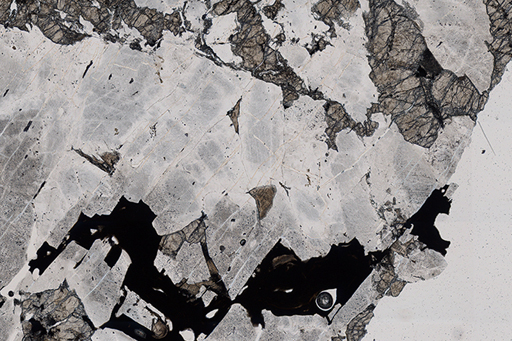2.5 Highland rock
Sample 78235 (open this link in a new tab or window so you have the two pages to work with) was collected from a boulder found on top of the regolith during the Apollo 17 mission. Its age has been determined as 4.3 billion years and it thus formed part of the early crust of the Moon. The sample is a light-coloured, coarse-grained plutonic rock, veined and partially coated with a dark-brown glass, which is a result of melting during an impact shock. (A plutonic rock is one that solidified from molten magma deep below the surface.) Micrometeorite impact pits on both the top and bottom of the sample indicate that the boulder had been turned over on the lunar surface.
In this rock the crystals are much larger than those in the mare basalt and they are also deformed, cracked and broken up. The larger crystal size is the result of the rock crystallising more slowly deep beneath the surface. The rock is very old, pre-dating the Late Heavy Bombardment when the surface of the Moon was very heavily cratered and any rocks at or beneath the surface were crushed and deformed. There are several features of this rock that indicate it has been deformed, but perhaps the most striking is the black vein of glass that splits the rock in two. This vein is known as a shock vein and was formed in the bottom of a crater during the explosion of an asteroid or the impact of a comet. You may recall from an earlier week that a comet is an icy body that can travel at tremendous speed and so make a very big crater.
Try to identify the pyroxene and plagioclase feldspar; it’s more difficult this time because they are so deformed, but in the view here the plagioclase is clear and the pyroxene is darker with a cracked surface.
The vein filled a crack in the rock which also formed during the asteroid or comet impact. What else can you determine about the event based on the thin section?

